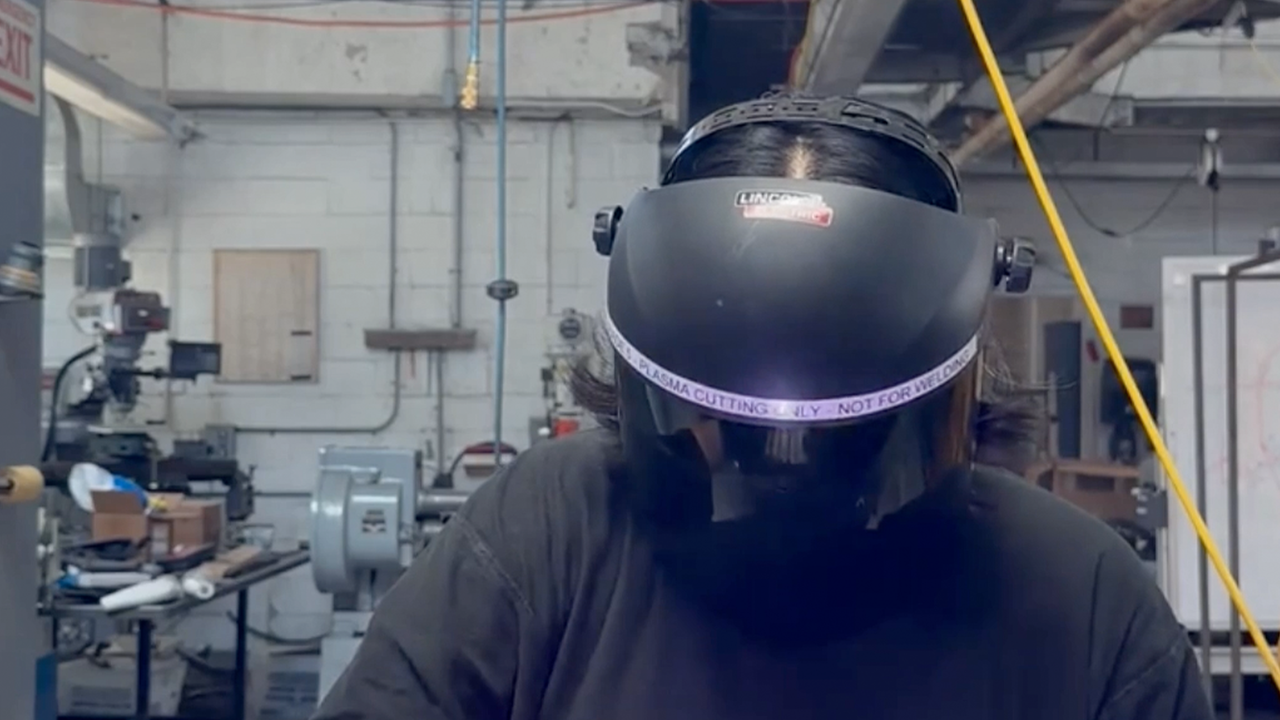Grace Wales Bonner on the Art That Influences Her
The British designer discusses the importance of sculpture, sound and archives to her practice
The British designer discusses the importance of sculpture, sound and archives to her practice

Andrew Durbin In a 2020 article for Dazed, you wrote that Terry Adkins was probably your favourite artist. There are many resonances between his practice and yours, but what is it that draws you to his work?
Grace Wales Bonner I really admire Adkins’s work. I find it very moving and I’m drawn to his ability to synthesize many different practices. Though I never met him, every time I encounter a sculpture of his I feel his presence. He imbued his art with a very magical and spiritual quality. I remember seeing a show of his work in New York and the gallerist explained that Adkins meditated with a lot of his pieces. There is a sense of life to what he created that is very joyful and experiential. I am really intrigued by the sonic potential of his work and the patina of the materials he uses. In my own practice, I am interested in how sound can charge objects or images with meaning, and it’s this impossible task that motivates me. Adkins exemplifies this pursuit.

AD Who else would you say is in your lineage as an artist, designer, curator?
GWB The library I am building is what I am plugging into as an artist, in the sense that I very much channel various ideas that have come before me. I shine a light on a lot of these ideas in my work. For example, Theaster Gates is someone I admire: he has such amazing taste and eye for detail. He pays close attention to the finest aspects of his writing and his use of poetic licence, his gathering of people, his musical expression, artworks and institution-building. I admire him because he has such a level of refinement across disciplines and scales – whether he’s concerned with the smallest linguistic detail in a piece of writing or the significant demands of town planning. He demonstrates how to work in different fields, and he has shown me possible pathways forward for my own practice. I find Gates’s level of ambition and physical manifestation attractive and seeing what he makes possible in this lifetime excites me.

AD Adkins thought deeply about archives of Black life, philosophy, experience and cultural practice – something that is echoed in Gates’s work. You, Adkins and, to some extent, Gates all explore the fine line between an archive and a shrine. It’s something you developed in your 2019 Serpentine Galleries exhibition, ‘A Time for New Dreams’. Does reframing an archive as a shrine change your relationship to its contents?
GWB I see the spiritual potential in archiving and in spending so much time with the creations of people who have come before me. Right now, I am thinking a lot about assemblage and how to arrange things intentionally in relation to each other. This connects to the idea of a shrine as something that is very intimate and precious. For me, working through archive material is like an engaged spiritual practice that enables me to access the sentiments and attitudes of different generations; it makes me feel very guided on a personal level.

AD Are there any archives, moments or generations you feel especially in touch with now? Or is your engagement with these histories broad?
GWB It’s a broad engagement with work of the African diaspora.
AD How has the PEEK Arts-Based Research Fund grant you received in 2021 supported and expanded your archive practice?
GWB I used it to develop ‘Between Critique and Hope’, my project exploring polyrhythm as a tool to organize an archive. It has given a space for my artistic practice to exist and be respected and cherished independently of my work in other fields. I have also been able to hire full-time researchers and to incorporate this practice into everything I do – whether it is seasonal collections or gallery exhibitions or musical experiences. It has been a very grounding and elemental process that allows me to operate at a more sustainable pace, outside of the fashion calendar. I want to find ways of slowing time and this four-year research grant provides the space to think through things on a different timeline and to invite people into this process of exploration.

AD When you were researching the collection of New York’s Museum of Modern Art for your upcoming exhibition, ‘Spirit Movers’, as part of their ‘Artist’s Choice’ series, did you encounter any surprises? How did your initial concept for the show evolve as you worked with the museum?
GWB I’ve been able to look at their special collection of artworks, but also at the history of exhibition design and at how art objects have been treated over time. This was something that really struck me. In the exhibition, I am trying to reach a certain purity in handling artworks and allowing the viewer to have a more direct encounter with them.
AD Museums are typically controlling of those encounters. How are you planning to open up the exhibition? Will you challenge some of the conventions of exhibition design?
GWB I am working within the parameters of what’s possible, but I intend to offer a highly personal and direct encounter with the collection.
AD The accompanying publication will bring together texts and images that partly focus on how sound can lead to the ‘spiritual brink of exultation’. I love this idea so much: was there a moment when it catalysed for you?
GWB I’ve always thought about the lineage of the photobook, and I can’t really separate images of Black life from orators of Black life. I was looking at photographs that captured this lyricism but also at how words and sound animate the images in reverse. Working towards the publication has been an opportunity to get close to some of the fundamental elements that motivate me. I am reaching for the expression of a very specific sort of beauty.

AD As someone interested in print culture, how do you plan to take on the genre of the museum catalogue, which can be rather fusty. Are there any ways you plan to challenge the print format?
GWB Collecting books and creating lasting records of things are crucial activities for me. To resist the formality of an exhibition catalogue, I wanted it to be more of a personal exploration or an artist’s book. This idea of purity and a direct encounter with materials has been my main approach to the publication, which is actually my first full-length book.
AD Does your attention to the spiritual aspect of art affect your approach to materiality, especially as a designer?
GWB As a designer, I’m interested in imbuing clothing with an emotional and soulful quality – I’m trying to capture a kind of materiality that transforms the way someone feels. I’m looking to explore and expand what can be embedded within material and within cloth.

AD There is this enduring image – in the popular imagination, at least – of artists and designers drawing inspiration from mood boards. But your notion of influence seems much broader and more complex, your engagement deeper and more sustained. In a 2023 interview with GQ, you described your work as ‘research as an artistic practice’. I’m wondering how you balance a sense of history with the liveness, the unknowability, of the present?
GWB I am interested in real people and real stories but, at the same time, I’m creating imaginative worlds that are brought together through images, text and sound. When you start to engage with the people who have inspired your work, it complicates this idealization and romanticism, which, in turn, really carries the work forward. I’m trying to resist a singular way of looking; rather, I’m hoping to create something people can convene around. My work is future-oriented, and I like to keep it open to the unknown and unknowable – an aspect which is often also present in the historical material that inspires me.
Audio recording by Dossiers HQ. To hear more stories, subscribe on Spotify and Apple Podcasts.
This interview first appeared in frieze issue 237 with the headline ‘Interview: Grace Wales Bonner’
Grace Wales Bonner’s ‘Artist’s Choice’ exhibition, ‘Spirit Movers’, will be on view from November 18 2023, through April 7 2024, at the Museum of Modern Art, New York
Main image: Grace Wales Bonner, Shrine II, 2019, installation view. Courtesy: © readsreads.info
























